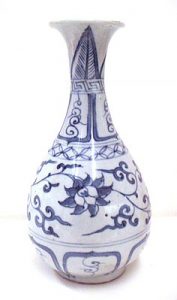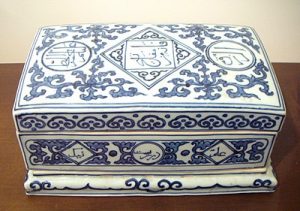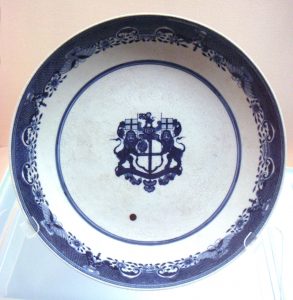Blue and white glazed pottery (14th century – early 17th century )
Getting to know pottery:
Blue and white pottery are often decorated with blue pigment (cobalt oxide), and then the maker would glaze it to protect the blue colour from fading. Pottery would typically be painted by hand with brush painting, but people also develop some other alternative methods such as stenciling or transfer printing to push the production. The reason why cobalt pigment is so comment pottery decoration is that it can resist high temperatures during the firing process. For other colours, pottery would need over glaze decoration and a second firing at low temperature to preserve its pigment.

Blue glazed pottery was originated in Iraq from the 14th century to replicate the colour of Lapis Lazuli (a type of deep blue expensive rock) after they learned how to make pottery from Chinese people. Decorating with cobalt blue became well known during the Yuan Dynasty and remained famous until now. Furthermore, blue and white pottery became the mainstream pottery during the Ming area and reached its peak during the time of Kangxi emperor of the Qing Dynasty. Also, during the 15th century, Europe start to became interested in the beauty of pottery, and it then became the symbol of wealth to western people.
So, what type of decorate style was developed from the 14th century to 17th century?
The evolution of blue and white pottery began during the beginning of the 14th century, and it gradually replaced the blush white ware pottery (Qingbai). The European came to China then got interested in these blue and white pottery and brought it into the international trade market. From the 14th to 15th century, pottery would be decorated with flower or pattern; some would also add the dragon image ( representing power and wealth).

Going to the 16th century, we get to see the character of the Persian and Arabic script on pottery as decoration which was influenced by the Islamic and Muslim

During the 17th century, the Chinese began to produce pottery to export the European market. We start to see English, and Latin letter on blue and white pottery and the decorating style also got highly inspired by Europe. People began to illustrate western scene or symbol on the pottery.

Lecture summary :
In this week lecture, we get to know more about the evolution of typography with Roman style with show a great progress comparing to want we learn last week. Roman style typography using thick line but still quite humanist. This time we also see the first book ever printed in English William Caxton and later on we also see the ” On the Revolutions of the Heavenly Spheres” which marking the beginning of the scientific revolution. In art, we see the Baroque art style with dramatic lighting and composition. One thing that I really like about this lecture is Baskerville typeface and punch cuter who pull of some impressive work.
\

